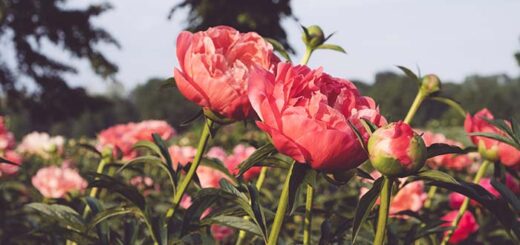Why Are Your Peonies Not Blooming? Identifying Common Problems
Are your peonies failing to bloom? This can be a major disappointment for any gardener who looks forward to the vibrant colors and lush beauty of blooming peonies.
In this guide, we’ll explore some common reasons why your peonies might be flowerless and what steps you can take to encourage them to bloom.
Brief Overview of the Main Issue
Sometimes, peonies do not produce flowers due to various factors, ranging from environmental conditions to care mistakes. Identifying the underlying cause is the first step towards solving this issue and ensuring a bountiful bloom in the next season.
What to Do When Your Peonies Remain Unbloomed
If your peonies do not show flowers, it is essential to assess several aspects of their care and environment.
Factors such as planting depth, sunlight exposure, and soil fertility play critical roles.
Vital steps are ensuring your peonies are planted at the proper depth, with the eyes (buds) set no more than two inches below the soil surface, and in a location that receives at least six hours of sunlight daily.
Moreover, enriching the soil with compost or a balanced fertilizer can provide the necessary nutrients for healthy growth and blooming.
Must Read Article: Care of peonies after they bloom
Are Ants Detrimental to Peony Blooms?
One of the most persistent myths among gardeners is the belief that ants are harmful to peonies and might be a reason for peonies not producing flowers.
This myth likely stems from the noticeable presence of ants on peony buds as they begin to open.
However, the truth is quite the opposite: ants are generally beneficial to peonies and are not the cause of blossom-less peonies.

Image Source: Envato Elements
The Role of Ants in Peony Health
Ants are attracted to peonies because of the nectar that the peony buds excrete. This nectar is rich in sugars, serving as an enticing treat for ants. In return for this nectar, ants offer a protective service. They fend off other potential pest insects that might be more harmful to the peony buds. The presence of ants crawling over peony buds is a natural and beneficial form of pest control.
Ants and Peony Blooms
The activity of ants on peony buds is often mistaken as a harmful interference with the flowers’ ability to open.
However, there is no evidence to suggest that ants prevent peony blooms. The buds would open with or without the presence of ants.
The role of ants is more about taking advantage of the peony’s nectar rather than influencing the blooming process.
Ants Are Not to Blame
If your peonies are not blooming, it is essential to look beyond the presence of ants for an explanation. Factors such as planting depth, sunlight exposure, and overall plant health are much more critical to peony blooming.
Ensuring that your peonies are planted at the correct depth, in well-draining soil, and in a spot that receives ample sunlight is crucial.
Additionally, providing your peonies with a balanced diet and adequate water will do more to promote blooming than removing ants could ever achieve.
Seven Common Reasons Why Peonies Do Not Bloom
Peonies are among the most beloved garden perennials, valued for their lush, colorful blooms. However, when they fail to flower, it can be disheartening.
Understanding the reasons behind this can help gardeners address the issues effectively.
Here’s an in-depth look at the common factors that can prevent peonies from blooming:
Incorrect Planting Depth
Peonies are susceptible to how deep they are planted. If planted too deeply, their buds (also known as “eyes”) may be too far beneath the soil surface to develop correctly.
The ideal planting depth for peony eyes is about 1.5 to 2 inches above the roots, depending on the type of peony and the climate.
Conversely, if planted too shallowly, the roots may not be adequately protected, leading to exposure damage and poor bud development.
Insufficient Sunlight
Sunlight is crucial for peonies to thrive and bloom. They require a minimum of six hours of direct sunlight each day. Less light can lead to weaker plants and sparse or non-existent blooms.
Planting peonies in a location that enjoys full sun most of the day is recommended for optimal growth and flowering.
Overcrowding
Peonies need space to grow. Overcrowding can result in competition for essential resources such as nutrients, water, and light.
This competition can stress the plants, leading to poor growth and reduced or no blooming. Regularly spacing peonies and dividing them every few years can ensure they have enough room to develop fully.
Recent Transplanting
Peonies typically do not bloom well the first year or two after being transplanted. They require time to establish themselves in their new location.
Disturbance of the roots during transplanting can also set back blooming. Patience is vital, as transplanted peonies may take a couple of growing seasons to recover and bloom abundantly.
Excessive Nitrogen
While nitrogen is an essential nutrient for plant growth, too much of it can lead to lush foliage at the expense of blooms. Excessive nitrogen can encourage rapid leaf growth, diverting energy from flower production.
To promote blooming, use a balanced fertilizer that provides a good mix of nutrients, including phosphorus, which supports healthy blooms.
Disease or Pests
Diseases such as botrytis blight or peony wilt and pests like thrips or aphids can significantly impact the health of peony plants. These issues can stress the plant and divert energy away from blooming.
Regular monitoring, proper sanitation, and appropriate treatment methods can help manage these problems and prevent them from affecting the blooms.
Age of the Plant
The age of the peony can also affect its blooming. Very young plants might need to mature more to start producing flowers. On the other hand, very old peonies can become less productive and may benefit from being divided.
Peonies are long-lived plants, and with proper care, they can return to a robust blooming phase even after a period of dormancy.
Addressing these issues can lead to healthier peony plants and abundant blooms.
Regular care, suitable growing conditions, and patience are crucial to enjoying peonies’ spectacular flowers.
Final Thoughts
Understanding why your peonies are barren is crucial to resolving the issue. By addressing factors like sunlight, soil conditions, and planting depth, you can help your peonies thrive and produce the beautiful blooms you anticipate each year.
Keep an eye out for any signs of disease or pests, and consider your plants’ age and general health as part of your regular garden maintenance.
With proper care, your peonies will delight you with their stunning flowers for many seasons.
Reference Sources:
Savvy Gardening: Peonies Not Blooming
Laidback Gardener: 9 Reasons Peonies Don’t Bloom
Gardening Know How: Peonies Not Blooming? 6 Reasons Why & Hot to Get More Flowers


